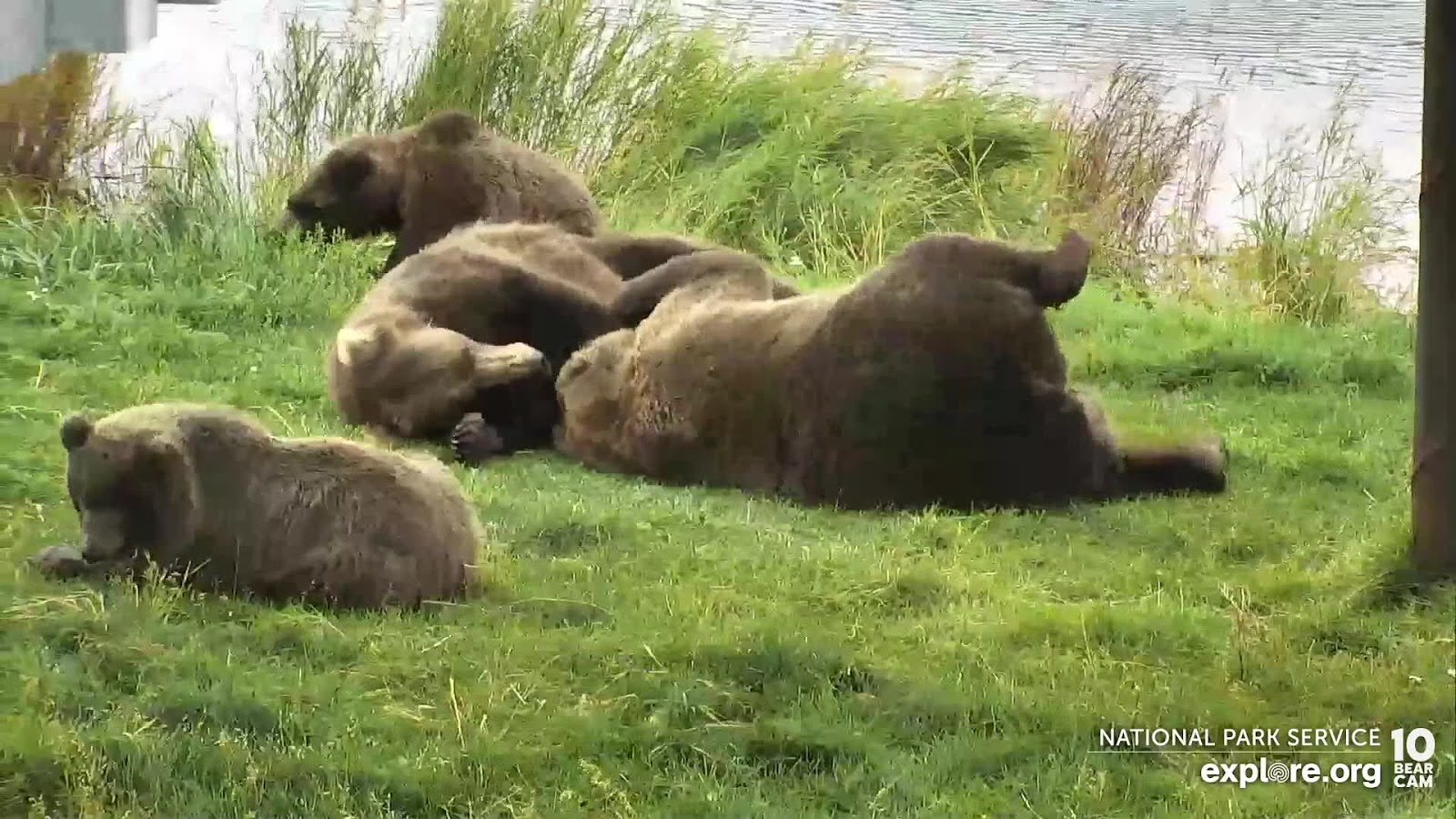A Sisterly Bond
By Mike Fitz
Mother bears experience extraordinary energetic demands to feed their ravenous cubs. Bear families navigate a gauntlet of threats to remain safe. Cubs experience a short apprenticeship with their mothers, and they must absorb her lessons if they are to survive life as independent bears. Although sibling bears can be closely bonded as cubs and young subadults, they typically spend little or no time together as adult bears. At least, that’s what they normally do. There is no such thing, however, as an average bear or average bear family.
Bears 909 and 910 are sisters from a litter born in 2016. After separating from their mother in the spring of 2018, I expected their familial bond to weaken through their subadult years at Brooks River in Katmai National Park, Alaska. They appeared to be on that path at first. We saw them together less and less frequently as they matured into adults. Then their behavior diverged from the typical, and they gave us a chance to see a rare example of bonded mother bears and their cubs.

The subadult bears 909 (right) and 910 (left) sit on a rock in Brooks River on July 22, 2018. National Park Service photo by T. Carmack.
In the summer of 2022, each sister returned to Brooks River with a cub. 909 was caring for a yearling (second-year) cub, while 910 was accompanied by a single spring (first-year) cub. As expected, the mothers and their cubs didn’t associate closely in early summer. By mid-August, though, they became an integrated family. Bonding between mother bears has been documented previously, but it remains rare and the circumstances that influence it aren’t well understood. The relationship between the 909-910 families was something I had never seen before, so I wrote a paper about it. Their story, in brief, was published in the scientific journal Ursus. (Thanks to explore.org for covering the publication and open access fees.)
Brown bears were characterized historically as solitary and asocial. Yet, bears are intelligent, recognize each other as individuals, and can express a high level of sociability. A team of researchers proposed recently that sociability in brown bears exists along a continuum. My observations of bear behavior support this idea. Some bears at Brooks River are loners while some bears play with other bears frequently, even seeking out the company of specific bears as regular playmates. 909 and 910’s bond was deeper than infrequent play bouts, though.
At the beginning of summer 2022, they used the same places along Brooks River to fish but did not seek friendly social interaction until August. Then, after about five or six weeks of fishing on that year’s large sockeye salmon run, the families bonded. They traveled, foraged, and played together until they were last seen at the river in mid-October. The cubs would remain near each other while the mothers fished separately. The mothers would allow their nieces to take fish from their daughters and did not typically move to discourage the behavior, a tolerance akin to that shown by a mother bear when her cubs compete amongst themselves for food. The cubs would play separately from the adults, the mothers would play separately from the cubs, and the mothers would play with one or both cubs.
Why did the families bond so closely in 2022? How did kinship, or their sense of it, influence their behavior? We’d have to ask them to know for sure. Since we can’t do that, then maybe we can draw some conclusions based on their behavior and biology. 909 and 910 are siblings from the same litter and were socialized to each other from their experiences together as cubs and subadults, so they weren’t strangers. More eyes in a group increases the chance of spotting threats in advance. The cubs found consistent playmates with each other and the adults. Brown bear cub survival appears to increase with greater rates of play. Strong social bonds between mother bears may also reduce cub mortality during periods of food scarcity or social stress.
Still, 909 and 910 aren’t the first sibling bears to use Brooks River as adults. Female bears often live in home ranges that overlap with their mothers, so encounters between sister and mother bears may not be rare at all. I suspect that the large salmon run at Brooks River in 2022 was a major influence on their behavior. Notably, the families did not unite as a cohesive group until early August, several weeks after sockeye salmon arrived at the river. Food competition and stress appeared greatly reduced by early August compared to late June and July. This was also on the heels of very large salmon runs at the river during the previous few years. 909 and 910 came of age when salmon runs in Bristol Bay and at Brooks River were uncommonly large.
But this begs another question. If access to ample food allows bears to be more sociable, and if greater sociability provides possible survival advantages, then why don’t more bear families at Brooks River behave like 909, 910, and their cubs?

909 and 910 play while their cubs graze on vegetation. Bearcam snapshot taken by GreenRiver on August 30, 2022.
Bears survive by feasting when food is available and enduring famine when food is lacking. Perhaps most bears cannot overcome innate feelings of wariness and uncertainty created by competition and hunger even when food is plentiful. A high level of sociability isn’t inherent in every bear personality either. I’d rather spend time alone than hang out in a crowded place. Some bears are like that too.
Maybe 909 and 910 and their cubs experienced the ideal set of circumstances in 2022 that allowed them to bond. They didn’t suffer from any injury or illness that would have limited their ability to socialize. They weren’t overtly wary or fearful of each other. The cubs were healthy, curious, and energetic. Food was of little worry. The young mothers had a long, friendly family history. The mothers and their cubs also seemed to have personalities that, for bears, are a bit extroverted.
Finally, let’s not discount that the families had a lot of fun together. They liked each other. Not every behavior can be reduced to mere hypotheses about survival and adaptation instincts. Instinct is a powerful influence on animal behavior including humans—for example, consider how your mood and behavior change when you feel especially hungry or after you eat a satisfying meal—but non-human animals aren’t instinctual robots. They have inner lives. I have no doubt the integrated family experienced joy when their bellies were full and they could relax and play as a group. Comfort, joy, and contentment are as much of a motivator in bear lives as they are in human lives.
The relationships between these bears changed after 2022 but didn’t end. In 2023, bear 909 separated from her then 2.5-year-old cub who was soon adopted by her aunt, 910. The 910 group often fished in close proximity to 909 at Brooks Falls, yet the adults remained separate. The 910 family, including the former 909 cub, remained together through October 2024.
What will we see from them this summer? We’re entering a true golden era of wildlife observation. The behavior, sentience, and intelligence of non-human animals are more accessible and knowable thanks to webcams and the collective observations of webcam viewers. 909 and 910 and their cubs showed us that the bear world is more than struggle, competition, and hardship. It is also joy, family, and friendship.
Although I mention this in the Ursus paper, the collective observations of bearcam viewers are invaluable and I would not have been able to write my 909/910 paper without your contributions. Thank you.



